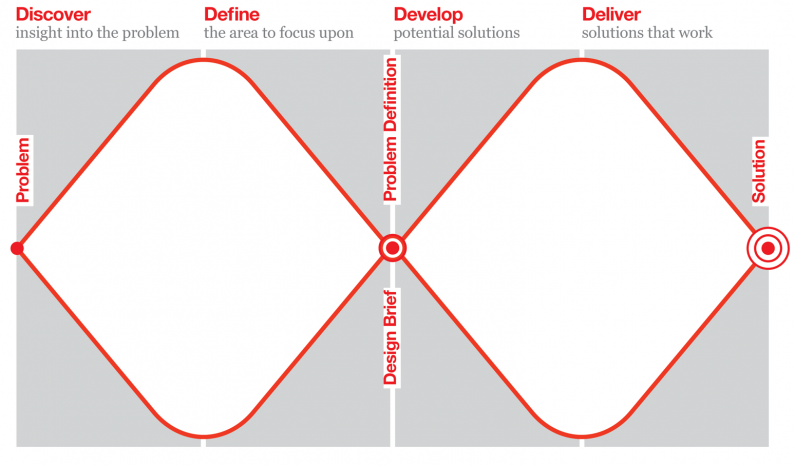

Solution space product discovery
source link: https://uxdesign.cc/solution-space-product-discovery-159422d4db2c
Go to the source link to view the article. You can view the picture content, updated content and better typesetting reading experience. If the link is broken, please click the button below to view the snapshot at that time.
Solution space product discovery
Or innovating from a place of knowledge

Hello and welcome to the final installment of my product discovery articles.
In part one, I proposed that it’s useful to distinguish between two types of product discovery challenges you’ll find yourself working on — Opportunity Space Discovery and Solution Space Discovery.
In part two, I honed in on Opportunity Discovery and my preferred techniques and ways of thinking to apply in this space.
Today I’ll finish the trifecta by focusing on Solution Space Discovery, where you’ll see an old favourite making an appearance…
🔍 Solution discovery overview
In Opportunity Discovery we were discovering which user problem, or opportunity, is worth pursuing.
In Solution Discovery the above has been discovered already so we are now discovering the best solution for it.
In other words, we’re doing Solution Discovery when we’re starting from a more known place, where we have some existing knowledge of or experience with.
There are two routes that can lead you to Solution Discovery.
You may arrive here from an Opportunity Discovery challenge where you worked your way through a number of user problems, or opportunities, and landed on one which showed solid evidence for strong customer value, technical feasibility and business viability. Meaning, you found a user problem the solving of which moves your desired outcome. In the process of testing the user problem, you experimented with several high-level, conceptual solutions against it and now you’ve got one which is worthy of further development.
Perhaps more often though, you will find yourself here when you’re working on improving, redesigning and optimising an existing product or experience.
While value, feasibility and viability are ongoing considerations in Solution Discovery, this is where UX’s favourite usability risk can finally enter the picture. This is because what we’re aiming to achieve as the ultimate outcome of this discovery stage is a usable, live solution to the aforementioned evidenced, viable and feasible user problem.
In other words, Opportunity Discovery is a juggle between user problems. Solution Discovery is a journey to successfully solving the most impactful user problem.
Double Diamonds are forever… ish?
The double diamond is a well-known framework for innovation and you may challenge me for not advocating for its usage in Opportunity Space discovery. My challenge back would be, well, how are you defining innovation?

When my product team was first faced with an Opportunity Discovery challenge, we approached it as any other “innovation” we had delivered before, namely through a double diamond-led lense. Every next challenge we got, we hit the ground running with a similar approach and felt like a well-oiled discovery machine.
But we were working in the Solution Space. Yes, we were overhauling existing user experiences and processes and in that sense were innovating.
Once we were out of the world of innovating “existing” things though, the approach didn’t work.
It wasn’t the Double Diamond’s fault. It’s just that as a framework it wasn’t an effective vehicle for product discovery at pace when dealing with the variety of constantly changing, very foundational and more strategic unknowns of opportunity assessment.
But innovating within the Solution space is still innovating. Just a different type of innovating and one for which the Double Diamond is still very much suited for.
How to level up your Double Diamond practice in Solution Discovery
Even though I still rate the ol’ double diamond and happily promote it, I will highlight a few common mistakes that will enable you to do better when applying it to your Solution Discovery challenges.
- It’s not a linear process
The way that the Double Diamond is visualised often makes people think that the work ahead of them is going to be very methodical and clear cut.
While it is a more methodical process than the one in Opportunity Discovery, you have to account for the fact that you will not only inevitably go back and forth within one diamond but you’ll likely also go back and forth between the two diamonds. You’ll have to kill ideas but you also might have to kill the problem driver you initially decided to hone in on as you test solutions for it.
- Not everything is about the user
Imagine a user researcher saying this and then imagine me getting my club membership revoked. But I did say that business viability and technical feasibility will continue to live as ongoing considerations in Solution Discovery.
Let’s say your task is to improve take up of a product that you’re already offering but is not performing as well as you believe it has the potential to.
You’ll look at your data and see where the biggest drop offs are happening. You will find out all the reasons why users are doing this in an actionable, prioritised order. What if the biggest reason is that your users don’t expect to pay for the product but your business is going to go bankrupt if it starts offering it for free?
In my greener days as a user researcher I worked on a retention optimisation challenge and pricing was the absolute biggest driver for user loss. I spent a stupid amount of time arguing the case for changing our pricing structure until I finally understood what the business model constraints were and could move on to solving for actually addressable problems.
- Testing is more than prototyping and user testing
For real though. You can afford to run small, hacky live tests in Solution Discovery too and you can definitely still get creative.
Note that I’m saying small and hacky. Oftentimes, when Double Diamonding we’re thinking of ideating, prototyping and user testing as the road to a proper live test of The Best Solution that is robustly designed and statistically significant. We’re thinking of this Test Of All Tests as the step which comes after coming out of the second diamond. But we’re missing opportunities for an array of other live experiments within the second diamond. The Test of All Tests is an expensive way to learn so must be backed by some cheaper signals before it earns its existence.
- You can run several double diamonds in parallel within your problem space
In my retention experience example, data analysis pointed the team to splitting the general problem space of retention drop off by two main user groups by payment type. A deep dive into loads of existing customer feedback confirmed that the two groups were highlighting different pain points with the experience. Group One was identified as a priority because of its size — solving for this group’s problems would lead to more substantial wins. But Group Two’s problems were much easier to solve.
The two group’s problems were completely different and so were the possible solutions but we ran two separate double diamonds for them in parallel. We could get learnings on Group One and go on to sharing and collaborating/negotiating with our stakeholders on the actions to take, while preparing and running the next cycle of testing with Group Two.
Working in Solution Discovery can also push you to make decisions fast, contrary to what many people around you may think. You just have to show them in practice.
- You can still end up killing the entire thing
This is especially true when you’re in the Solution space because you’re often improving something existing. You not only have to be prepared to go back and forth within one diamond, as well as between the two diamonds, but you might go all the way back to your opportunity assumption and end up invalidating your entire entry point.
My team could’ve found out that there is absolutely nothing we can do to increase retention. Period. That it’s at its optimal point and nothing short of giving stuff for free (and going bankrupt in five minutes) would move the needle.
Go into it with an open mind and communicate with stakeholders constantly so it doesn’t catch them off guard if it happens.
And if this all sounds a bit familiar…
… it might be because you’re recognising some key principles from Opportunity Discovery.
I truly believe that some aspects of the Opportunity mindset could and should be applied here — humility in solutionizing, creative solution testing, readiness to scrap pain points the solving of which isn’t producing the best results as juicy as the pain point may be…
But in my experience with both Opportunity and Solution challenges, and in my own experimenting with the approaches you can apply to them, I’ve found that going in with the full Opportunity Discovery arsenal in a Solution space is overkill. Moreover, the discovery framework ends up overtaking the discovery work itself.
Used in an Opportunity space, the Opportunity framework protects you from getting in too deep too early. But in a Solution space, it doesn’t allow you to get deep enough when you actually do need to get into a bit more detail.
Used in an Opportunity space, the Solution framework is slow and plunges you into a level of detail you don’t have a need for at the point of looking for evidence that a worthwhile user problem exists. But in its proper home, where the scope and understanding of the foundational user problem is present, the approach can provide an orderly and enabling way to get to the ultimate goal — a usable, live solution.
And that’s the third and final instalment of my product discovery series. I am planning an article on the role of the user researcher in modern product discovery in the near future so hit the follow button if you’re interested in that.
I would love to hear your stories of product discovery successes and failures, tools and approaches you’ve encountered along the way, lessons you’ve learned and want to pass on, and thoughts and ideas you have about the future of this ever-changing discipline.
Thank you for reading!
Recommend
About Joyk
Aggregate valuable and interesting links.
Joyk means Joy of geeK